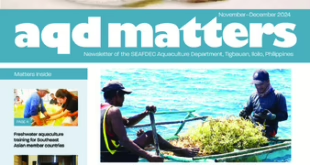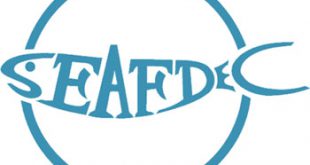 Technology Description
Technology Description
It might be expensive to integrate broodstock with hatchery; hence, hatchery operators may opt to buy milkfish eggs from broodstock operators like SEAFDEC/AQD. This distinction between egg suppliers and fry suppliers is what make Taiwan’s milkfish industry very successful because the risks are spread among sectors of the industry. Filipino entrepreneurs are enjoined to do the same.
Eggs are hatched, raised, and then sold at day 21 or older. Natural food (Chlorella, Brachionus, Artemia) are fed to the larvae, enriching the rotifer and Artemia in particular with highly unsaturated fatty acids (HUFA) and Vitamin C. The SEAFDEC/AQD-formulated larval feed may be given in combination with natural food from day 3-5 until harvest. Water change, cleaning tanks, frequent monitoring of stock and support systems like aeration are part of the hatchery routine.
| Technology profile: | |
| (1) A shrimp hatchery may be slightly modified by adding algal and rotifer tanks. A volume ratio of 1 ton larval rearing tank to 3 tons algal-rotifer tanks is recommended.
(2) Natural food production must start at least two weeks before the hatchery receives eggs or larvae. To culture Chlorella, start with a 1-liter starter culture in 20 liters of seawater. Fertilize with ammonium phosphate 16-20-0 and urea 46-0-0 both at 15 mg per liter plus ammonium sulfate 21-0-0 at 100 mg per liter. Aerate, and wait for the algal population to reach its peak density, usually in 3-4 days. Then add 70 liters of water. Fertilize. Continue scaling-up the algae culture until you have a 9-ton outdoor tank seeded with 1000 liters of Chlorella. This will probably take 24 days. (3) Start the mass culture of Brachionus by directly seeding concentrated culture into the 9-ton Chlorella tank. Brachionus peaks in density in 3-4 days. Harvest using a 60-micron filter bag. Note that Brachionus is scaled-up the same way as algae, starting with 10-liter cultures and using Chlorella as feed. (4) When the natural food is ready, bring in the milkfish eggs. Acclimate then stock at 300 eggs per liter for optimum hatching which takes place in 14 to 16 hours. (5) Prepare the rearing tanks by seeding 1 liter “greenwater” (Chlorella at its peak density) for every 30 liters of seawater. Stock 30 larvae per liter. (6) Maintain a green to light green color of seawater throughout the hatchery run. Make sure to maintain 10-15 Brachionus per ml for the first 15 days; then reduce this to 0.5 per ml until harvest. Enriched Artemia is added to the diet in lieu of more Brachionus. About 0.5 Artemia per ml is maintained from day 15 to 17, then increase to 1 per ml onwards. (7) To enrich Artemia, feed first with HUFA booster diets with Vitamin C supplementation (available commercially) before giving to milkfish fry. Or, feed Artemia with microalgae high in HUFA. (8) SEAFDEC/AQD formulated diet may also be given in lieu of the expensive Artemia, at 12.5 g per ton per day, from day 15 to 25. (9) Clean rearing tanks daily by siphoning debris out of the tank bottom; change 30% of the water from day 1 to day 15, then 50-70% until harvest. (10) Harvest when you have buyers on day 21. Drain tanks to about a foot of water. Scoop out fry and place in plastic basins. Pack larvae in double-layered oxygenated plastic bags at 300 fry per liter. (11) If a pond is available, the hatchery operator can nurse the hatchery-reared fry for two weeks with minimal expenses (fry thrive on naturally grown food organisms), and double the selling price of the milkfish fry. |
|
References:
Agbayani RF, Lopez NA, Tumaliuan RE, Berjamin GD. 1991. Economic analysis of an integrated milkfish broodstock and hatchery operation as a public enterprise. Aquaculture 99:235-248
Bagarinao TU. 1994. Systematics, distribution, genetics and life history of milkfish, Chanos chanos. Environmental Biology of Fishes 39:23-41
Bagarinao TU. 1999. Ecology and farming of milkfish. SEAFDEC Aquaculture Department, Tigbauan, Iloilo. 171p
Bagarinao T, Lantin-Olaguer I. 2000. From triphenyltins to integrated management of the ‘pest’ snail Cerithidea cingulata in mangrove-derived milkfish ponds in the Philippines. Hydrobiologia 437:1-16
Borlongan IG. 1992. Dietary requirement of milkfish (Chanos chanos Forsskal) juveniles for total aromatic amino acids. Aquaculture 102:309-317
Borlongan IG. 1992. The essential fatty acid requirement of milkfish (Chanos chanos Forsskal). Fish Physiology and Biochemistry 9:401-407
Borlongan IG, Coloso RM. 1993. Requirements of juvenile milkfish (Chanos chanos Forsskal) for essential amino acids. Journal of Nutrition 123:125-132
Borlongan IG, Marte CL, Nocillado JN. 2000. Development of larval diets for milkfish (Chanos chanos). Journal of Applied Ichthyology 16:68-72
Chaudhuri H, Juario JV, Primavera JH, Samson R, Mateo R. 1978. Observations on artificial fertilization of eggs and the embryonic and larval development of milkfish, Chanos chanos (Forskal). Aquaculture 13:95-113
de Jesus EG. 1994. Thyroid hormone surges during milkfish metamorphosis. Israeli Journal of Aquaculture – Bamidgeh 46:59-63
Duray M, Bagarinao T. 1984. Weaning of hatchery-bred milkfish larvae from live food to artificial diets. Aquaculture 41:325-332
Emata AC, Marte CL. 1994. Natural spawning, egg and fry production of milkfish, Chanos chanos (Forsskal), broodstock reared in concrete tanks. Journal of Applied Ichthyology 10:10-16
Emata AC, Marte CL, Garcia LMaB. 1992. Management of milkfish broodstock. Aquaculture Extension Manual No. 20, SEAFDEC Aquaculture Department, Tigbauan, Iloilo. 22 p
Feed Development Section. 1994. Feeds and feeding of milkfish, Nile tilapia, Asian sea bass, and tiger shrimp. Aquaculture Extension Manual No. 21, SEAFDEC Aquaculture Department, Tigbauan, Iloilo. 97 p
Garcia LMaB, Agbayani RF, Duray MN, Hilomen-Garcia GV, Emata AC, Marte CL. 1999. Economic assessment of commercial hatchery production of milkfish (Chanos chanos Forsskal) fry. Journal of Applied Ichthyology 15:70-74
Garcia LMaB, Marte CL, Traviña VS. 1988. A collecting gear for naturally-spawned milkfish (Chanos chanos Forsskal) eggs in circular floating net cages. Aquaculture 68:83-86
Gapasin RSJ, Marte CL. 1990. Milkfish hatchery operations. Extension Manual No. 17, SEAFDEC Aquaculture Department, Tigbauan, Iloilo. 24 p
Gapasin RSJ, Bombeo R, Lavens P, Sorgeloos P, Nelis H. 1998. Enrichment of live food with essential fatty acids and vitamin C: effects on milkfish (Chanos chanos) larval performance. Aquaculture 162:269-286
Hilomen-Garcia GV. 1997. Morphological abnormalities in hatchery-bred milkfish (Chanos chanos Forsskal) fry and juveniles. Aquaculture 152:155-166
Juario JV, Duray MN, Duray VM, Nacario JF, Almendras JME. 1984. Induced breeding and larval rearing experiments with milkfish Chanos chanos (Forskal) in the Philippines. Aquaculture 36:61-70
Juario JV, Storch V. 1984. Biological evaluation of phytoplankton (Chlorella sp., Tetraselmis sp. and Isochrysis galbana) as food for milkfish (Chanos chanos) fry. Aquaculture 40:193-198
Liao IC, Juario JV, Kumagai S, Nakajima H, Natividad M, Buri P. 1979. On the induced spawning and larval rearing of milkfish, Chanos chanos (Forskal). Aquaculture 18:75-93
Marte CL, Lacanilao F. 1986. Spontaneous maturation and spawning of milkfish in floating net cages. Aquaculture 53:115-132
Marte CL. 1988. An improved method for collecting naturally spawned milkfish eggs from floating cages. Aquaculture 71:387-392
Miñoso MGG, Borlongan IG, Satoh S. 1999. Essentiality of phosphorus, magnesium, iron, zinc, and manganese in milkfish diet. Fisheries Science 65:721-725
Toledo JD, Gaitan AG. 1992. Egg cannibalism by milkfish (Chanos chanos Forsskal) spawners in circular floating net cages. Journal of Applied Ichthyology 8:257-262
Sumagaysay NS, Hilomen-Garcia GV, Garcia LMB. 1999. Growth and production of deformed and non-deformed hatchery-bred milkfish (Chanos chanos) in brackishwater ponds. Israeli Journal of Aquaculture – Bamidgeh 51:106-113
 SEAFDEC/AQD Southeast Asian Fisheries Development Center | Aquaculture Department
SEAFDEC/AQD Southeast Asian Fisheries Development Center | Aquaculture Department

